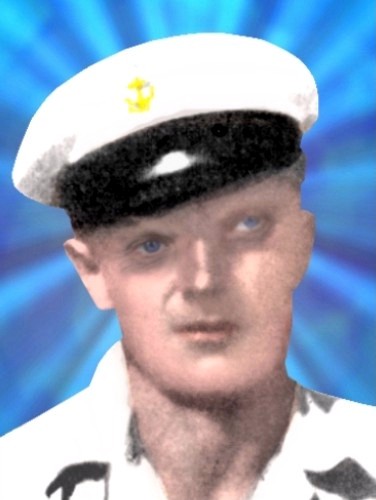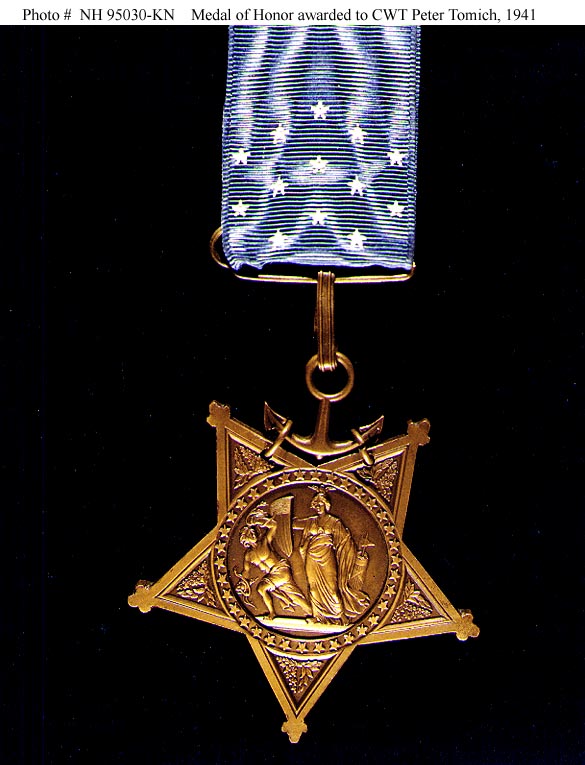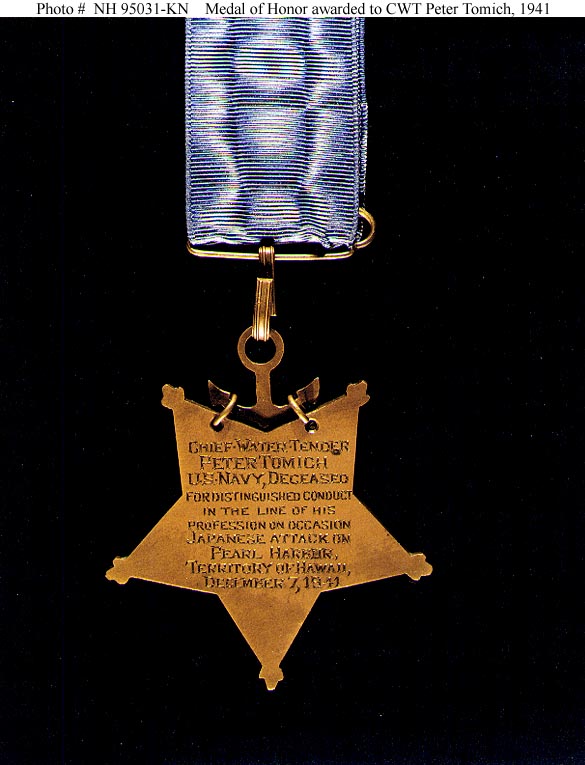American Vice President Cheney plans to award the Peter Tomich Medal of Honor to his next of kin during his visit to Croatia this month May 2006.

 |  |
TOMICH, PETER Medal of Honor
THE PETER TOMICH UNCLAIMED MEDAL OF HONOR
or
Peter Tonic-Tomic-Herceg
By Adam S. Eterovich
There are only two Medals of Honor in American history that are not claimed because a next-of-kin could not be found, one in the Indian Wars and Peter Tomich at Pearl Harbor, Hawaii on December 7, 1941. He died a hero on the battleship Utah.
His next-of-kin, John Tomich in Los Angeles, could not be found and the Navy dropped the matter as his records simply stated born in Prolog, Austria. So, for 60 years the Navy, Medal of Honor Society and the Croatian community did nothing thru no fault of their own.
Approximately 15 years ago (1985) I asked a journalist, Vjekoslav Krsnik, from Split, Croatia to visit Mali and Veli Prolog in Dalmatia and Prolog in Hercegovina and ask for the names Tonic and Tomic and since these were small places , we should turn up something. To our surprise no Tonic-Tomic originated in Mali or Veli Prolog, but at Prolog in Hercegovina Vjekoslav found that Tonic was the Clan Name for Herceg. We had found our hero, his birthplace and his Croatian nationality. We obtained birth and other records from Prolog which were extremely useful.
Admiral J. Robert Lunney of New York has probably contributed more than anyone in his help, cooperation and labor to present to the proper Naval authorities adequate proof that we do have a next-of-kin. Last year he traveled to Prolog to view the original Church and Civil records. His first submission to the Navy was rejected and since then a second Legal Brief has been filed. We also wish to thank my good friend Don Chvarak, a Croatian American War Veteran, of Texas, Admiral Robert A. Rosen, Senators Robert G. Torricelli and Max Cleland. Also special thanks to Mato Herceg here in California and a Vietnam Veteran, a native of Prolog, who updated and uncovered new documentation and president Bernard Luketich of the Croatian Fraternal Union for graciously publishing material on Peter Tomich in the Zajednicar.
The Navy is confused because of “Prolog, Austria”; Tonich changed to Tomich, then being advised that the name is really Herceg and that he is a Croatian from Hercegovina that had been Turkey in his father’s lifetime. It does get confusing.
We are pleased to report to have found a direct relative of the next-of-kin, now deceased, his grandson, Srecko Herceg a Lt. Col. in the Croatian Army living in Split, Dalmatia. He received five medals for valor in battle against Serbian forces in the late war in Croatia. We also have a relative, Mato Herceg, living in California. Now we have two heroes, it must in their blood...Hercegovci are known for their stubborness, loyalty, honor and as superior warriors against all odds. Peter Tomich-Herceg beat the Japanese in the Pacific and Srecko Herceg beat the Serbs in Croatia and Hercegovina. We do hope to have Srecko Herceg brought to America or Mato Herceg to receive the Medal from the President of the United States.
I would like this Medal to be deposited at the Croatian Fraternal Union Museum in Pittsburgh.
TOMICH, PETER
Peter Tonich was born in Prolog, Austria, on June 3. 1893. He enlisted in U. S. Army at Fort Solcum, New York, on June 6, 1917, and served with the 12ti- Company, 3rd Training Battalion, 154th Depot Brigade, Camp Greene, North Carolina, and also with Company L, 47th Infantry, Camp Greene, North Carolina. He was honorably discharged January l3, 1919.
Tonich was naturalized at Charlotte, Mecklenburg County, North Carolina, on October 10, 1918. He enlisted in the U. S. Navy at Newark, New Jersey, on January 23, 1919, at which time his name was recorded as Tonich. Later he used the name Tomich in signing official papers. Tonich (Tomich) served continuously in the Navy from the time of his enlistment and was advanced through the enlisted ratings to that of Chief Watertender on June 4, 1930.
Tonich (Tomich) was serving aboard the USS UTAH at Pearl Harbor when the Japanese attacked the Fleet on December 7, 1941, and was killed in that action. For his heroism on this historic occasion he was awarded the Medal of Honor, posthumously, by the President of the United States, with the following citation:
Medal of Honor
"For distinguished conduct in line of his profession and extraordinary courace and disregard of his own safety during the attack on the Fleet in Pearl Harbor, Territory of Hawaii, by the Japanese forces on December 7, 1941. Although realizing that the ship was capsizing, as a result of enemy bombing and torpedoing, he remained at his post in the engineering plant of the USS UTAH, until he saw that all boilers were secured.and all fireroom personnel had left their stations, and by so doing he lost his own life."
He was also awarded the Purple Heart Medal, posthumously.
In addition to the Medal of Honor and the Purple Heart Medal, Tonich (Tomich) was entitled to the American Defense Service Medal, Fleet Clasp, the Asiatic-Pacific Area Campaign Medal, and the World War II Victory Medal.
A Destroyer Escort vessel, the USS TOMICH, DE-242, was named in his honor.
OTHER MEDALS OF HONOR:
BUCHA, PAUL WILLIAM
Rank and organization: Captain, U.S. Army, Company D, 3d Battalion. 187th Infantry, 3d Brigade, 101st Airborne Division. Place and date: Near Phuoc Vinh, Binh Duong Province, Republic of Vietnam, 16-19 March 1968. Entered service at., U.S. Military Academy, West Point, N.Y. Born: I August 1943, Washington, D.C. Citation, For conspicuous gallantry and intrepidity in action at the risk of his life above and beyond the call of duty.
Capt. Bucha distinguished himself while serving as commanding officer, Company D, on a reconnaissance-in force mission against enemy forces near Phuoc Vinh, The company was inserted by helicopter into the suspected enemy stronghold to locate and destroy the enemy, During this period Capt. Bucha aggressively and courageously led his men in the destruction of enemy fortifications and base areas and eliminated scattered resistance impeding the advance of the company. On 18 March while advancing to contact, the lead elements of the company became engaged by the heavy automatic weapon, heavy machinegun, rocket propelled grenade, claymore mine and small-arms fire of an estimated battalion-size force. Capt. Bucha, with complete disregard for his safety, moved to the threatened area to direct the defense and ordered reinforcements to the aid of the lead element. Seeing that his men were pinned down by heavy machinegun fire from a concealed bunker located some 40 meters to the front of the positions, Capt. Bucha crawled through the hail of fire to singlehandedly destroy the bunker with grenades.
During this heroic action Capt. Bucha received a painful shrapnel wound. Returning to the perimeter, he observed that his unit could not hold its positions and repel the human wave assaults launched by the determined enemy. Capt. Bucha ordered the withdrawal of the unit elements and covered the withdrawal to positions of a company perimeter from which he could direct fire upon the charging enemy. When friendly element retrieving casualties was ambushed and cut off from the perimeter, Capt. Bucha ordered them to feign death and he directed artillery fire around them. During the night Capt. Bucha moved throughout the position, distributing ammunition, providing encouragement and insuring the integrity of the defense. He directed artillery, gunship and Air Force gunship fire on the enemy strong points and attacking forces, marking the positions with smokegrenades. Using flashlights in complete view of enemy snipers, he directed the medical evacuation of 3 air-ambulance loads of seriously wounded personnel and the helicopter supply of his company. At daybreak Capt. Bucha led a rescue party to recover the dead and wounded members of the ambushed element.
During the period of intensive combat, Capt. Bucha, by his extraordinary heroism, inspirational example, outstanding leadership and professional competence, led his company in the decimation of a superior enemy force which left 156 dead on the battlefield. His bravery and gallantry at the risk of his life are in the highest traditions of the military service, Capt. Bucha has reflected great credit on himself, his unit, and the U.S. Army.
The original name of Capt. Bucha was Buha. His people came from Slavonia in Croatia. He is now the President of the Medal of Honor Society in America.
CUKELA, LOUIS (Army Medal)
Rank and organization: Sergeant, U.S. Marine Corps, 66th Company 5th Regiment. Place and date: Near Villers-Cotterets, France, 18 July 1918. Entered service at: Minneapolis, Minn. Born: I May 1888, Sebenes, Austria. G,O. No.: 34, W.D., 1919. (Also received Navy Medal of Honor.) Citation: When his company, advancing through a wood, met with strong resistance from an enemy strong point, Sgt. Cukela crawled out from the flank and made his way toward the German lines in the face of heavy fire, disregarding the warnings of his comrades. He succeeded in getting behind the enemy position and rushed a machinegun emplacement, killing or driving off the crew with his bayonet. With German handgrenades he then bombed out the remaining portion of the strong point, capturing 4 men and 2 damaged machine guns. Sgt. Cukela was born in Sibenik, Dalmatia and the origins of Cukela come from the Island of Solta. My good friend, Ante Jakovcevic, from Solta proved that he is a Croatian Catholic with origins in Solta. He is one of the few that received two Medals of Honor.
CUKELA, LOUIS (Navy Medal)
Rank and organization: Sergeant, U.S. Marine Corps, 66th Company, 5th Regiment. Born: I May 1888, Sebenes, Austria. Accredited to: Minnesota. (Also received Army Medal of Honor.) Citation: For extraordi nary heroism while serving with the 66th Company, 5th Regiment, dur ing action in the Forest de Retz, near Viller-Cottertes, France, 18 July 1918. Sgt. Cukela advanced alone against an enemy strong point that was holding up his line. Disregarding the warnings of his comrades, he crawled out from the flank in the face of heavy fire and worked his way to the rear of the enemy position. Rushing a machinegun emplacement, he killed or drove off the crew with his bayonet, bombed out the remaining part of the strong point with German handgrenades and captured 2 machineguns and 4 men.
NOVOSEL, MICHAEL J.
Rank and organization: Chief Warrant Officer, U.S. Army, 82d Medical Detachment, 45th Medical Company, 68th Medical Group. Place and date: Kien Tuong Province, Republic of Vietnam, 2 October 1969. Entered service at: Kenner, La. Born: 3 September 1922, Etna, Pa. Citation: For conspicuous gallantry and intrepidity in action at the risk of his life above and beyond the call of duty. CWO Novosel, 82d Medical Detachment, distinguished himself while serving as commander of a medical evacuation helicopter. He unhesitatingly maneuvered his helicopter into a heavily fortified and defended enemy training area where a group of wounded Vietnamese soldiers were pinned down by a large enemy force. Flying without gunship or other cover and exposed to intense machinegun fire, CWO Novosel was able to locate and rescue a wounded soldier. Since all communications with the beleaguered troops had been lost, he repeatedly circled the battle area, flying at low level under continuous heavy fire, to attract the attention of the scattered friendly troops. This display of courage visibly raised their morale, as they recognized this as a signal to assemble for evacuation. On 6 occasions he and his crew were forced out of the battle area by the intense enemy fire, only to circle and return from another direction to land and extract additional troops. Near the end of the mission, a wounded soldier was spotted close to an enemy bunker. Fully realizing that he would attract a hail of enemy fire, CWO Novosel nevertheless attempted the extraction by hovering the helicopter backward. As the man was pulled on aboard, enemy automatic weapons opened fire at close range, damaged the aircraft and wounded CWO Novosel. He momentarily lost control of the aircraft, but quickly recovered and departed under the withering enemy fire. In all, 15 extremely hazardous extractions were performed in order to remove wounded personnel. As a direct result of his selfless conduct, the lives of 29 soldiers were saved. The extraordinary heroism displayed by CWO Novosel was an inspiration to his comrades in arms and reflect great credit on him, his unit, and the U.S. Army.
CWO Novosel’s people came from Ribnik in Croatia.
GRBITCH, RADE
Rank and organization: Seaman, U.S, Navy. Born: 24 December 1870, Austria. Accredited to: Illinois. G.O. No.: 13, 5 January 1906. Citation: On board the U.S. Bennington, for extraordinary heroism displayed at the time of the explosion of a boiler of that vessel at San Diego, Calif., 21 July 1905.
Grbitch is Grbic and his origins are in Dalmatia, Croatia. He is buried at the Presidio of San Francisco.
TOMINAC, JOHN J.
Rank and organization: First Lieutenant, U.S. Army, Company 1, 15th infantry, 3d Infantry Division. Place and date: Saulx de Vesoul, France, 12 September 1944. Entered service at: Conemaugh, Pa. Birth: Conemaugh, Pa. G.O. No.: 20, 29 March 1945. Citation: For conspicuous gallantry and intrepidity at risk of life above and beyond the call of duty an 12 September 1944, in an attack on Saulx de Vesoul, France. lst Lt. Tominac charged alone over 50 yards of exposed terrain onto an enemy roadblock to dispatch a 3-man crew of German machine gunners with a single burst from his Thompson machinegun. After smashing the enemy outpost, he led one of his squads in the annihilation of a second hostile group defended by mortar, machinegun, automatic pistol, rifle and grenade fire, killing about 30 of the enemy. Reaching the suburbs of the town, he advanced 50 yards ahead of his men to reconnoiter a third enemy position which commanded the road with a 77-mm. SP gun supported by infantry elements. The SP gun opened fire on his supporting tank, setting it afire with a direct hit. A fragment from the same shell painfully wounded Ist Lt. Tominac in the shoulder, knocking him to the ground. As the crew abandoned the M-4 tank, which was rolling down hill toward the enemy, ist Lt. Tominac picked himself up and jumped onto the hull of the burning vehicle. Despite withering enemy machinegun, mortar, pistol, and sniper fire, which was ricocheting off the hull and turret of the M-4, Ist Lt. Tominac climbed to the turret and gripped the 50-caliber antiaircraft machinegun. Plainly silhouetted against the sky, painfully wounded, and with the tank burning beneath his feet, he directed bursts of machinegun fire on the roadblock, the SP gun, and the supporting German infantrymen, and forced the enemy to withdraw from his prepared position. Jumping off the tank before it exploded, Ist Lt. Tominac refused evacuation despite his painful wound. Calling upon a sergeant to extract the shell fragments from his shoulder with a pocketknife, he continued to direct the assault, led his squad in a handgrenade attack against a fortified position occupied by 32 of the enemy armed with machineguns, machine pistols, and rifles, and compelled them to surrender. His outstanding heroism and exemplary leadership resulted in the destruction of 4 successive enemy defensive positions, surrender of a vital sector of the city Saulx de Vesoul, and the death or capture of at least 60 of the enemy.
His people are from Croatia.
VADAS, ALBERT
Rank and organization: Seaman, U.S. Navy. (Named changed to Wadas, Albert.) Born: 26 March 1876, Austria-Hungary. Accredited to: New York. G.O. No.: 521, 7 July 1899. Citation: On board the U.S.S. Marblehead during the operation of cutting the cable leading from Cienfuegos, Cuba, I I May 1898. Facing the heavy fire of the enemy, Vadas displayed extraordinary bravery and coolness throughout this period. More detailed records stated he was from Fuma (Fiume), Fiume is Italian for Rijeka, Croatia. The name Vadas-Wadas was Vidas from the Rijeka district.